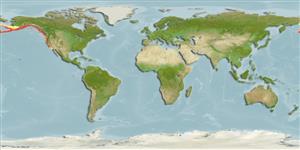Environment: milieu / climate zone / depth range / distribution range
Ökologie
seewasser demersal; tiefenbereich 10 - 1370 m (Ref. 50610). Temperate; 65°N - 31°N, 178°E - 117°W
Eastern Pacific: Navarin Canyon in the Bering Sea to Stalemate Bank in the Aleutian Islands and San Cristobal Bay, Baja California, Mexico.
Length at first maturity / Size / Gewicht / Alter
Maturity: Lm 38.5, range 38 - 40 cm
Max length : 76.0 cm TL Männchen/unbestimmt; (Ref. 2850); common length : 40.0 cm TL Männchen/unbestimmt; (Ref. 56527); max. veröff. Gewicht: 3.5 kg (Ref. 56527); max. veröff. Alter: 56 Jahre (Ref. 74500)
Rückenflossenstacheln (insgesamt): 0; Rückenflossenweichstrahlen (insgesamt): 90-116; Afterflossenstacheln 0; Afterflossenweichstrahlen: 80 - 96; Wirbelzahl: 50 - 54. Dorsal origin above middle of upper eye. Caudal imperfectly rounded.
Adults occur on mud bottom (Ref. 2850). They move into deep water in winter (Ref. 2850). Produce large amounts of slime which may cover other fishes when caught in trawls (Ref. 4925). Marketed as mink food (Ref. 4925) or as fillet (Ref. 2850).
Vinnikov, K.A., R.C. Thomson and T.A. Munroe, 2018. Revised classification of the righteye flounders (Teleostei: Pleuronectidae) based on multilocus phylogeny with complete taxon sampling. Molecular phylogenetics and evolution, 125:147-162. (Ref. 122998)
IUCN Rote Liste Status (Ref. 130435)
Bedrohung für Menschen
Harmless
Nutzung durch Menschen
Fischereien: kommerziell; Sportfisch: ja
Mehr Information
ReferenzenAquakulturAquakultur ProfilZuchtlinienGenetikElectrophoresesVererbbarkeitKrankheitenVerarbeitungNutrientsMass conversion
Tools
Zusatzinformationen
Download XML
Internet Quellen
Estimates based on models
Preferred temperature (Ref.
123201): 1.1 - 6.3, mean 3.5 °C (based on 248 cells).
Phylogenetic diversity index (Ref.
82804): PD
50 = 0.5625 [Uniqueness, from 0.5 = low to 2.0 = high].
Bayesian length-weight: a=0.00646 (0.00367 - 0.01135), b=3.07 (2.91 - 3.23), in cm total length, based on LWR estimates for this species & (Sub)family-body (Ref.
93245).
Trophic level (Ref.
69278): 3.2 ±0.1 se; based on diet studies.
Widerstandsfähigkeit (Ref.
120179): niedrig, Verdopplung der Population dauert 4,5 - 14 Jahre. (tm=5; tmax=56; K=0.26; Fec=37,000).
Prior r = 0.35, 95% CL = 0.23 - 0.52, Based on 3 stock assessments.
Fishing Vulnerability (Ref.
59153): High to very high vulnerability (71 of 100).
Climate Vulnerability (Ref.
125649): Moderate vulnerability (43 of 100).
Nutrients (Ref.
124155): Calcium = 14.7 [8.7, 29.4] mg/100g; Iron = 0.211 [0.121, 0.389] mg/100g; Protein = 16.7 [14.7, 18.8] %; Omega3 = 0.337 [0.163, 0.715] g/100g; Selenium = 27.8 [13.8, 59.9] μg/100g; VitaminA = 7.77 [1.73, 33.10] μg/100g; Zinc = 0.373 [0.269, 0.554] mg/100g (wet weight); based on
nutrient studies.
